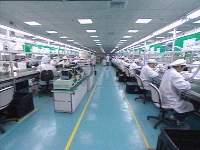 As the competitiveness of its manufacturers develops, China’s potential as a so-called world factory has emerged as a hot topic. The Pearl River and Yangtze River deltas have earned the name of “world factory floor”. However, as more overseas competitors holding WTO passports enter China, players on this floor have begun to spark innovative ideas to gain ground in the world marketplace. In today’s Business Life, we will guide you to these two river deltas to see how businesspeople there keep the “world factory” running, and work toward China’s economic supremacy. As the competitiveness of its manufacturers develops, China’s potential as a so-called world factory has emerged as a hot topic. The Pearl River and Yangtze River deltas have earned the name of “world factory floor”. However, as more overseas competitors holding WTO passports enter China, players on this floor have begun to spark innovative ideas to gain ground in the world marketplace. In today’s Business Life, we will guide you to these two river deltas to see how businesspeople there keep the “world factory” running, and work toward China’s economic supremacy.
Just north of Hong Kong, the Chinese mainland’s Pearl River Delta occupies the low-lying areas adjacent to the river of the same name that flows into the South China Sea. While the delta region only has a population of 30 million and a land area similar to that of Malaysia, it accounted for almost 40 percent of the whole country’s exports last year.
 Because of its seemingly inexhaustible supply of cheap labor, massive foreign investment and a reduction of international trade barriers, the Pearl River Delta has become China’s most affluent region and one of the world’s principal manufacturing basins, churning out everything from baby toys to power tools.
Because of its seemingly inexhaustible supply of cheap labor, massive foreign investment and a reduction of international trade barriers, the Pearl River Delta has become China’s most affluent region and one of the world’s principal manufacturing basins, churning out everything from baby toys to power tools.
As one saying goes: “If a traffic jam occurred between Hong Kong and Dongguan city of Guangdong Province, 70 percent of the computer assembly businesses around the world would suffer a supply shortage.” But the Pearl River Basin is not only important to computer businesses. According to the provincial officials, geography is the most important reason for the region’s success.
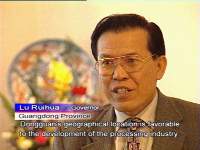 Lu Ruihua, Governor of Guangdong Province: Dongguan’s geographical location is favorable to the development of the processing industry. If you travel to the mainland via Hong Kong, the first stop will be Shenzhen. And then Dongguan. Dongguan is very large and the labor force is very good. Therefore, lots of processing industries have appeared in Dongguan and also a large number of Taiwanese businesspeople have come to Dongguan. Dongguan has become a complete processing area. This is not very common in the world.
Lu Ruihua, Governor of Guangdong Province: Dongguan’s geographical location is favorable to the development of the processing industry. If you travel to the mainland via Hong Kong, the first stop will be Shenzhen. And then Dongguan. Dongguan is very large and the labor force is very good. Therefore, lots of processing industries have appeared in Dongguan and also a large number of Taiwanese businesspeople have come to Dongguan. Dongguan has become a complete processing area. This is not very common in the world.
Factories in Dongguan, just 50 miles north of Hong Kong, produced nearly 40 percent of the world's disk drives and 10 percent of its computer monitors in 2002, not to mention tens of millions of scanners, printers and DVD players. Dongguan, along with a cluster of cities on the Pearl River Delta, has set cost and price standards for these products worldwide. Some multinational corporations have shifted their global purchasing functions to the delta, propelling the region into the center of world procurement.
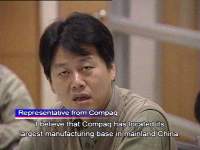 Representative from Compaq: Most of Compaq’s purchasing centers are in Asia. I believe that Compaq has located its largest manufacturing base in Chinese mainland. Based in Dongguan, we will develop our businesses nationwide. Dongguan is very important for Compaq computer manufacturing.
Representative from Compaq: Most of Compaq’s purchasing centers are in Asia. I believe that Compaq has located its largest manufacturing base in Chinese mainland. Based in Dongguan, we will develop our businesses nationwide. Dongguan is very important for Compaq computer manufacturing.
In 1978, the Chinese government began a reform process that opened the Pearl River Delta to foreign trade and investment. This historic change gave the Pearl River Delta a head start compared with the rest of the mainland in developing private enterprises, manufacturing capabilities and foreign trade. Maximizing interaction with the outside world, the Pearl River Delta has demonstrated its capabilities as a manufacturing powerhouse to the world.
Shopping for a pair of shoes? You will find a wide variety produced here in small-town factories along the Pearl River Delta where nimble Chinese hands sew nearly 80 percent of the footwear purchased in the United States. The world’s largest shoe manufacturing base is located in Dongguan where you can find Nike, Reebok and Adidas.
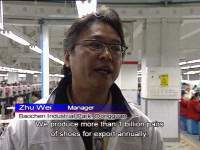 Zhu Wei, manager of Baochen Industrial Park, Dongguan: Baochen is number one in the world in shoe manufacturing. We produce more than one billion pairs of shoes for export annually.
Zhu Wei, manager of Baochen Industrial Park, Dongguan: Baochen is number one in the world in shoe manufacturing. We produce more than one billion pairs of shoes for export annually.
Apart from shoes, 60 percent of the clothing by such brand names as Pierre Cardin and Ports are manufactured in this river delta. "Made in China" commodities have penetrated every corner of the world. Many of the exports made in factories owned or run by foreigners carry familiar western brand names. All this undoubtedly brings tremendous profits to the region. However, it seems no longer to fulfill the ambitions of local people.
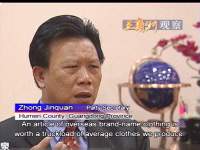 Zhong Jinquan, Party secretary of Humen County, Guangdong Province: An article of overseas brand-name clothing is worth a truckload of average clothes we produce. We need a brand, a fashion culture.
Zhong Jinquan, Party secretary of Humen County, Guangdong Province: An article of overseas brand-name clothing is worth a truckload of average clothes we produce. We need a brand, a fashion culture.
With this awareness, more and more home-grown Chinese enterprises in the region have started to create their own hot-selling Chinese brands.
This is a new product release held in Humen, a county south of Dongguan. Overseas clothing purchasers from Europe, the US and the Middle East have signed agent agreements with the local firms to sell Chinese clothes abroad.
 An American designer: I’d like to see a little bit more international-like (design), imaginative, creative. It’s growing, it’s growing rapidly.
An American designer: I’d like to see a little bit more international-like (design), imaginative, creative. It’s growing, it’s growing rapidly.
Within two years, more than one thousand domestic brands are created in Humen. While the production volume has remained the same, sales last year jumped by 30 percent.
Part of this can be attributed to changing attitudes in the world markets. Chinese-designed goods are gaining greater acceptance. As Chinese players on the so-called world factory floor gain strength in the increasingly competitive global markets, these businesses are expected to stabilize their position as the world’s manufacturing leader.
The pearl of south China's Pearl River Delta is still glimmering. But a rival is emerging on the Yangtze Delta that includes Shanghai and the provinces of Jiangsu and Zhejiang.
The Pearl River Delta has become one of China's most dynamic regions, because of its huge role in the reform and opening-up drive. Now, it has to withstand some fierce competition from a Yangtze Delta region with Shanghai as the head of an enormous dragon extending into the hinterland.
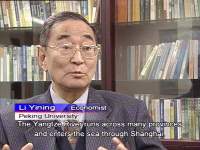 Li Yining, economist with Peking University: The Yangtze River is a golden channel. The Yangtze River runs across many provinces and enters the sea through Shanghai. (As an important port city) Shanghai drives the prosperity and development of the whole Yangtze River Delta. The cities around Shanghai, such as Kunshan and Suzhou, are the places where many overseas investors are concentrated. So the development of Yangtze River Delta is much more promising.
Li Yining, economist with Peking University: The Yangtze River is a golden channel. The Yangtze River runs across many provinces and enters the sea through Shanghai. (As an important port city) Shanghai drives the prosperity and development of the whole Yangtze River Delta. The cities around Shanghai, such as Kunshan and Suzhou, are the places where many overseas investors are concentrated. So the development of Yangtze River Delta is much more promising.
It takes less than two hours to drive from Suzhou to Shanghai. This ideal location has guaranteed Suzhou’s place as a sizeable IT manufacturing base. Nearly 10,000 overseas investors have ventured into the city. Among these, 1,000 are IT companies. The Japan-based Canon is one of them.
 Masami Idenuma, president of the Canon (Suzhou) Inc.: We found that Suzhou has many advantages. First, it’s advantageous in location, near Shanghai. This is very convenient for product distribution and shipping. Second, it's very easy to find suppliers here. Third, there is no shortage of excellent professionals.
Masami Idenuma, president of the Canon (Suzhou) Inc.: We found that Suzhou has many advantages. First, it’s advantageous in location, near Shanghai. This is very convenient for product distribution and shipping. Second, it's very easy to find suppliers here. Third, there is no shortage of excellent professionals.
Led by Shanghai, the 15 cities cluster within 100,000 square kilometers produced one-fifth of the nation’s GDP and accounted for nearly 30 percent of the nation’s foreign trade last year.
Of the 35 richest cities on the Chinese mainland, 10 are located in the Yangtze River Delta. And, among the top 100 companies in the world, half have located here. The Yangtze River Delta is attracting these investors in large numbers for many reasons. One factor is the well-structured cooperation between Shanghai and its satellite communities. Another is the standard incentive offered by the government. The bigger a company is, the bigger the incentives it can command.
Andrew Telecommunication, a US electronics company, came to the region in 1999. The company’s general manager said he was most impressed by the speed, quality and efficiency of the local government.
 Michael Barbalas, general manager of Andrew Telecommunication (China) Co. Ltd.: The important thing is regardless where the company locates in China, you'll find the government policies about the same. And the most important thing is the efficiency. We've been very happy here in Suzhou, the local government is very professional, responding very quickly."
Michael Barbalas, general manager of Andrew Telecommunication (China) Co. Ltd.: The important thing is regardless where the company locates in China, you'll find the government policies about the same. And the most important thing is the efficiency. We've been very happy here in Suzhou, the local government is very professional, responding very quickly."
To date, contractual foreign investment in the area has approached 150 billion US dollars. With China's WTO entry and its rapid economic growth, a number of multinational corporations such as General Electric, Hewlett-Packard and Dell have recently declared their intentions to expedite investment in the region.
Analysts predict that by 2010 the Pearl River and the Yangtze River deltas will produce half of China’s GDP. Some experts say the success of these two economic powerhouses is mainly because of their geographic advantages, but other economists disagree.
 Cai Fang, researcher of Chinese Academy of Social Sciences: The success of these two river deltas has enlightened us that the geographical advantage is not decisive. It is the reforms and opening-up drive, the innovative systems and technical breakthroughs that are the real catalysts. These two deltas inspire an innovative spirit when we develop the local economy.
Cai Fang, researcher of Chinese Academy of Social Sciences: The success of these two river deltas has enlightened us that the geographical advantage is not decisive. It is the reforms and opening-up drive, the innovative systems and technical breakthroughs that are the real catalysts. These two deltas inspire an innovative spirit when we develop the local economy.
Despite China’s spectacular progress in recent years, its industries remain far behind their developed counterparts in technology, managerial expertise and marketing know-how. Fortunately, more and more skilled professionals have been getting involved in Chinese enterprise management.
An HR Manager from Taiwan: At present, there are still some people who think that products labeled “Made in China” mean there must be some quality problems. However, through our efforts, this image has changed gradually. Talent cultivation is critically important not only in the areas of technological development and creation, but also in market planning. We need different kinds of talents to support and coordinate.
To become a stronger manufacturing power in the world, the Pearl River Delta and the Yangtze River Delta still have a long way to go. As more products with technical content and added value are produced to international standards, the “Made in China” label will stand for innovation and world quality.
|